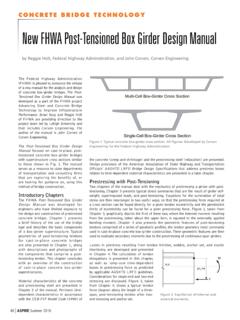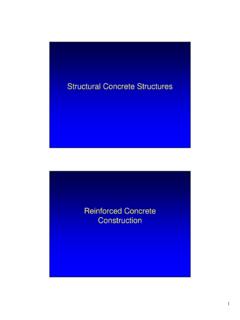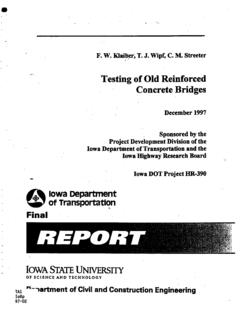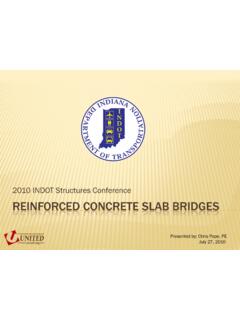Transcription of Service Life and Sustainability of Concrete Bridges
1 12 | ASPIRE, Fall 2009 PERSPECTIVESome notable Concrete Bridges have been constructed in the United States in recent years using criteria developed to ensure Service life of 100 to 150 years. However, these examples have been limited to a relatively small number of large and exceptional projects. Limited consideration of extended Service life in the United States may partially be a result of the lack of an AASHTO specification on this subject. The AASHTO LRFD Specifications1 provides these definitions: Service Life The period of time that the bridge is expected to be in operation. Design Life Period of time on which the statistical derivation of transient loads is based: 75 years for these Specifications. Since Service life involves consideration o f m a n y e n v i ro n m e n t a l , d e s i g n , materials, and construction factors, the LRFD definition of design life obviously does not represent a basis for Service life.
2 Accordingly, the AASHTO LRFD Specifications does not recommend any specific time period for Service an inter national basis, British Standards have required a minimum Service life design of 120 years since This requirement has also been implemented in other parts of the world where British Standards are used. The range of Service life criteria internationally is indicated by the 300-year target Service life of the Second Gateway bridge now under construction in Brisbane, Australia, with an 850 ft-long, cast-in-place Concrete , balanced cantilever main span. Special serviceability limit state specifications as well as special Concrete specifications were developed for the Confederation bridge between New Brunswick and Prince Edward Island to ensure a minimum Service life of 100 years. Service life of 100 years has been used for major bridge and tunnel projects in Europe since the early The Oresund Fixed Link between Denmark and Sweden, opened to traffic on July 1, 2000, utilized Concrete specifications developed to ensure a Service life of 100 In 1994, the owner and the consultants for the Oresund Fixed Link established the following as the basis for the Concrete specification requirements: The requirements will be based on well-known technology, and will secure a Service life of 100 years with proper maintenance but without any major repair work.
3 For purposes of this discussion, the Service life period will be considered to be the time period to be achieved with proper maintenance but without any major repair work. This would preclude, for example, complete removal and replacement of the bridge United Nations defined sustainable development as meeting the needs of people today without destroying the resources that will be needed by future generations. Increasing the Service life of major Bridges from 75 to 120 or 150 years without major repair work would obviously greatly reduce the resources required for a given installation on an annual basis. From this by Cliff Freyermuth,CLF Life and Sustainability of Concrete BridgesThe I-35W bridge Replacement in Minneapolis uses a fixed, anti-icing spray technology (FAST) system. The bridge has been designed for a 100-year Service life.
4 Photo: , Fall 2009 | 13perspective, sustainable development and Service life are clearly article includes discussion of Sustainability of Concrete Bridges in comparison to alternative materials; Service life, including comments on life-cycle costs; and concludes with discussion of design options that have been used or have become available recently that might be considered to achieve a Service life of 120 to 150 years for major Concrete this article deals primarily with major Concrete Bridges , extended Service life is considered necessary for all Bridges to achieve a sustainable bridge infrastructure. Different Service life levels might be appropriate in an eventual AASHTO specification depending on factors such as initial cost, importance, location, and average daily is the case with all industries in the United States, and in most of the industrialized world, major efforts have been underway for a number of years by the cement and Concrete industries to improve the Sustainability of Concrete construction and Concrete products.
5 There have been positive results from this work to date, and the efforts are continuing. From the standpoints of energy consumption and CO2 emissions, a 1978 study comparing the embodied energy of 5-m-long beams designed to provide equal load capacity5 provided the following results:Prestressed Concrete : 2100 kWhth 100% reinforced Concrete : 2750 kWhth 130%Structural Steel: 5460 kWhth 260%Where kWhth is the thermal energy in kilowatt hoursThese results were essentially confirmed by a 2007 life-cycle Notwithstanding the significant energy consumption and CO2 emissions related to Concrete bridge construction, these studies indicate that Concrete alternatives compare favorably to the primary competitive material on the basis of these important Sustainability noted in the introductory comments, the resources required for a given installation are substantially reduced on an annual basis by extending the Service life, provided that the Service life is achieved without major repairs.
6 Or large unexpected maintenance LifeThe lack of AASHTO specification provisions concerning the length of Service life is an obvious obstacle to the implementation of extended Service life for bridge projects in the United States. Development of specific Service life recommendations for Bridges would probably involve an effort by the AASHTO Subcommittee on Bridges and Structures and the Federal Highway Administration extending over a number of years. On the basis of international practice discussed earlier, Service life of 100 to 150 years is considered to be achievable, and has been implemented in the United States on an ad hoc basis by owners of major bridge projects. From the perspective of Sustainability of the national bridge infrastructure, continued ad hoc implementation of 100- to 150-year Service life for major Bridges seems appropriate until AASHTO specifications are technology related to factors and mechanisms governing the performance of structures throughout their Service lives continues to evolve ,8 The Great Belt Link,3 developed to provide a Service life of 100 years, has been re-evaluated using the technology presented in Reference 8, published in 1999.
7 On this basis, it appears that 150-year Service life can be San Francisco-Oakland East Bay Skyway bridge was designed for a 150-year Service life. Photo: Caltrans. While this article deals primarily with major Concrete Bridges , extended Service life is considered necessary for all Bridges to achieve a sustainable bridge | ASPIRE, Fall 2009 FiguRe 1 - Percentage of Bridges in the 2006 National bridge Inventory by material type. Figure: Brett Pielstick, Eisman & Russo 2 - Percentage of structurally deficient Bridges in the 2006 National bridge Inventory by material type. Figure: Brett Pielstick, Eisman & Russo CostsThe four components of life-cycle costs are:Construction (Owner s cost)Maintenance (Owner s cost)Traffic Management (Owner s cost)Traffic delay costs (Users costs)The August 1, 2007, failure of the I-35W bridge in Minneapolis, Minn., provides an important example of user costs that may be associated with replacement or repair of a major urban bridge , or an important bridge on a lifeline highway.
8 In this case, the Minnesota Department of Transportation (DOT) established a user cost related to this failure of $400,000 per day. For the 413-day period that the I-35W bridge was out of Service , the user costs become $165,200,000. The user costs were held at this level in this case only because of the unprecedented achievement of replacing the bridge in an 11-month period. From this perspective, small marginal cost increases that may be associated with design and construction of such Bridges to ensure an essentially uninterrupted Service life of 150 years are clearly 2006 National bridge Inventory (NBI) data lists 73,798 Bridges ( ) as structurally The 2006 NBI data by material type, and the 2006 structurally deficient Bridges by material type are shown in Figs. 1 and 2, These data are considered to provide an approximate index of maintenance, traffic management, and traffic delay costs for Bridges of different material types.
9 The figures indicate that the structural deficiency rate for steel Bridges is substantially greater than for Concrete Bridges . In numerical terms, the structural deficiency rate for steel Bridges reflected by the 2006 NBI data is times that of prestressed Concrete Bridges , and times that of conventionally reinforced Concrete Bridges . The most problematic component of life-cycle calculations may be maintenance costs. Nearly all states experience chronic deficiencies in funding available for maintenance. The lack of adequate maintenance funding may be a significant factor contributing to the structural deficiency of Bridges . Proper maintenance is essential to achieving extended Service life, as well as a sustainable bridge infrastructure. It would be futile to implement procedures intended to achieve 100- to 150-year Service life without a related commitment to provide the funding necessary to ensure proper Options for Achieving extended Service LifeDesign options that have been used to extend Service life include:1.
10 High-performance Concrete (HPC) to reduce Pretensioning and/or post-tensioning to control or eliminate Minimizing use of expansion joints and bearings (integral Bridges where feasible).4. Integral deck overlays on precast con-crete segmental Bridges in aggressive are two additional design options that might be considered to further enhance Service life and Sustainability . These are:1. Selective use of stainless steel reinforcing (SSR). Several States have used SSR in trial applications, including Oregon, Michigan, Missouri, and New Jersey. Most recently, 100 tons of SSR were used in the decks of the fixed and moveable bascule spans of the Woodrow Wilson Memorial bridge Replacement by Maryland and Virginia. The bid prices for this application ranged from $ to $ The price submitted by the successful bidder was $ , a premium of $ over the cost of ASPIRE, Fall 2009 | 15 FiguRe 3 - Selective use of stainless steel reinforcement in the pylons in the Stonecutter s bridge , Hong Kong.











